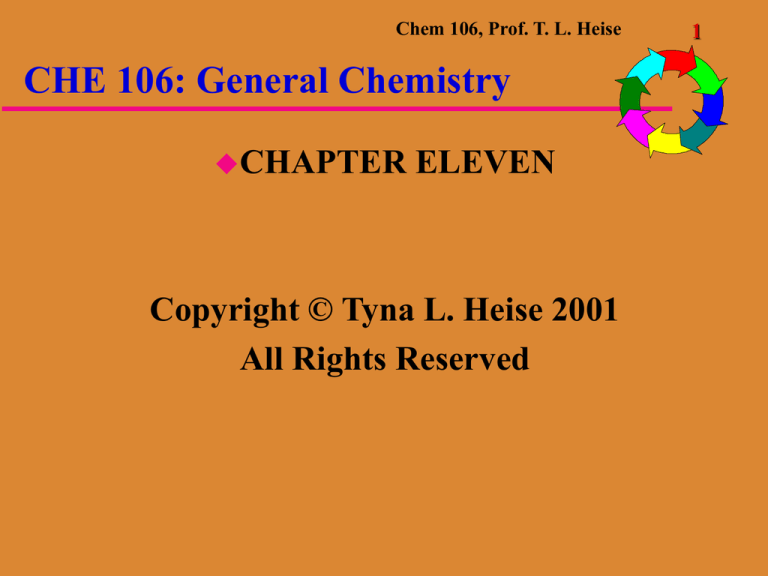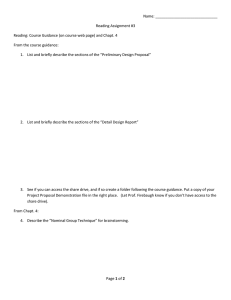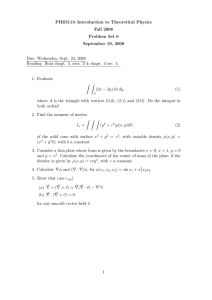
Chem 106, Prof. T. L. Heise
CHE 106: General Chemistry
CHAPTER
ELEVEN
Copyright © Tyna L. Heise 2001
All Rights Reserved
1
Chem 106, Prof. T. L. Heise
2
Molecular Comparison
of Solids and Liquids
All
elements can exist in three different phases of
matter
– Chemical properties remain the same
– Physical properties are different
– Many of the substances to be considered in solid
and liquid phase are molecular
» Virtually all liquids are molecular
» Physical properties examined are due to the
forces of attractions NOT within a molecule
BUT between molecules
Chapt. 11.1
Chem 106, Prof. T. L. Heise
3
Solids, Liquids, and Gases
Chapt. 11.1
Chem 106, Prof. T. L. Heise
4
Solids, Liquids, and Gases
Substances can be changed from one phase to another by
-heating and cooling to change the average kinetic
energy
-adding and decreasing pressure changes the
distance between molecules which leads to an
alteration in intermolecular forces
- increasing pressure pushes molecules
closer together, increasing molecular
attraction
- decreasing pressure allows molecules to
spread farther apart, decreasing molecular
attraction
Chapt. 11.1
Chem 106, Prof. T. L. Heise
5
Intermolecular Forces
The strengths of intermolecular forces of different
substances vary greatly, however they are much weaker
than ionic or covalent bonds:
You are not actually breaking apart a molecule,
just separating molecules from each other as you
move from solid to liquid and the to a gas phase.
Physical Properties reflect the IM forces
- boiling points
- melting points
Chapt. 11.2
Chem 106, Prof. T. L. Heise
6
Intermolecular Forces
Three types of IM forces:
dipole - dipole forces
ion - dipole forces
London dispersion forces
hydrogen bonding
Chapt. 11.2
Chem 106, Prof. T. L. Heise
7
Ion - Dipole forces
Important in aqueous solutions
- important between an ion
and the partial charge on
the end of a polar compound
negative ion attracts to +
positive ion attracts to Chapt. 11.2
Chem 106, Prof. T. L. Heise
8
Dipole - Dipole forces
Important in aqueous solutions
- important between two dipoles
negative end attracts to +
positive end attracts to -
**for molecules of equal size, the
strengths of dipole forces
increases with electronegativity
Chapt. 11.2
Chem 106, Prof. T. L. Heise
9
London Dispersion forces
Important between two nonpolar molecules
- important to look at instantaneous electron arrangements
- at an instant, the position of an electron can force a
temporary dipole moment.
- the temporary dipole moment can induce its’ neighbor to
experience a temporary dipole moment, causing an attraction
- this force is only significant when the molecules are very
close to each other
Chapt. 11.2
Chem 106, Prof. T. L. Heise
10
London Dispersion forces
Chapt. 11.2
Chem 106, Prof. T. L. Heise
11
London Dispersion forces
The amount of polarizability increases with size of
molecule.
- boiling point increases with molecular weight
The more contact a molecule has with another also increases
the polarizability
- n-pentane has higher boiling point than
neopentane due to larger available surface area
Chapt. 11.2
Chem 106, Prof. T. L. Heise
12
Hydrogen Bonding
A special intermolecular
force which exists between
the H of one molecule and
the O, F, or N of a
neighboring polar
molecule
Chapt. 11.2
Chem 106, Prof. T. L. Heise
13
Hydrogen Bonding
Chapt. 11.2
Chem 106, Prof. T. L. Heise
14
Intermolecular Forces
Summary: Intermolecular Forces can be determined
using
1. Composition
2. Structure
Dispersion forces are in ALL molecules
•Strengths increase with increased weight,
and depend on shape
Dipole-dipole forces add to dispersion forces
and are found ONLY in polar molecules
Hydrogen bonds are found between the H of
one molecule and the F, O, or N of another
None of these are as strong as ionic or covalent
bonds, but of these, hydrogen bonding is the
strongest
Chapt. 11.2
Chem 106, Prof. T. L. Heise
15
Properties of Liquids
Two important properties of Liquids:
Viscosity - the resistance of a liquid to flow
low viscosity flows easily
high viscosity flows slowly
Surface Tension - the energy required to
increase the surface area of a liquid by a
unit amount.
Molecules at surface all are attracted
inwards instead of in all directions, this
packs surface molecules closer together
The measurement of the inward forces that
must be overcome is the surface tension
Chapt. 11.3
Chem 106, Prof. T. L. Heise
16
Properties of Liquids
Viscosity
Chapt. 11.3
Chem 106, Prof. T. L. Heise
17
Properties of Liquids
Surface Tension
Chapt. 11.3
Chem 106, Prof. T. L. Heise
18
Phase Changes
Many important properties of liquids and solids relate
to the ease in which they change from one state to
another:
Chapt. 11.4
Chem 106, Prof. T. L. Heise
19
Phase Changes
Each phase change is accompanied by a change in
energy of the system.
Energy must be added to
overcome intermolecular
forces and achieve a less
ordered state.
Energy must be released as
intermolecular forces begin
to form and a molecule
achieves a more ordered
state
Chapt. 11.4
Chem 106, Prof. T. L. Heise
20
Phase Changes
Heating Curves: plot of the process of changing phase
of substance
Heat of Fusion: the
energy needed to
change a solid to a
liquid
Heat of
Vaporization: the
amount of energy
needed to change a
liquid to a gas
Chapt. 11.4
Chem 106, Prof. T. L. Heise
21
Phase Changes
Special Notes:
Supercooling: reducing the heat of the liquid so
fast it’s temperature falls below its
freezing point , but it remains a liquid.
This occurs because the liquid never has
a chance to form an ordered solid.
Critical Temperature: Highest temperature at
which a substance can exist as a liquid
Critical Pressure: The pressure needed to bring
about liquefaction at critical temp.
Chapt. 11.4
Chem 106, Prof. T. L. Heise
22
Vapor Pressure
Molecules can escape from the surface of liquid into
the gas phase by vaporization or evaporation.
Chapt. 11.5
Chem 106, Prof. T. L. Heise
23
Vapor Pressure
Why?
•Molecules of liquids move at various speeds
•At any instant a molecule on the surface may
possess enough energy to overcome its
intermolecular forces and escape into the gas phase
•The movement of molecules between liquid and
gas phases goes on continuously, eventually only so
many molecules can escape in a closed container
and a dynamic equilibrium will be attained
Chapt. 11.5
Chem 106, Prof. T. L. Heise
24
Vapor Pressure
Open Containers
•As liquid evaporates, the gas molecules move away
from surface of liquid, causing the possibility of
recapture by the liquid to be very small
•Equilibrium never occurs, and the vapor continues
to form until the liquid is gone
•Liquids that easily evaporate due to low
intermolecular forces, creating a high vapor
pressure in a closed container, are considered
volatile
Chapt. 11.5
Chem 106, Prof. T. L. Heise
25
Vapor Pressure
Boiling Point: the temperature at which the vapor
pressure equals the external pressure acting on the
surface of the liquid.
Normal Boiling Point: the
boiling point of a liquid at
1 atm
Chapt. 11.5
Chem 106, Prof. T. L. Heise
26
Phase Diagrams
Chapt. 11.6
Chem 106, Prof. T. L. Heise
27
Structures of Solids
Crystalline Solid: particles are in a well
ordered arrangement
- flat surfaces or surfaces at
definite angles to each other
- orderly stacking of particles
causes them to have orderly shapes
- examples - quartz and diamonds
- melts at specific temperature
Chapt. 11.7
Chem 106, Prof. T. L. Heise
28
Structures of Solids
Amorphous Solid: particles have no orderly
structure
- mixtures of molecules that do not
stack well together.
- composed of large complicated
molecules
- examples: rubber and glass
- intermolecular forces vary in
strength from one part of solid to
another due to irregularities in
solid, melting point varies
Chapt. 11.7
Chem 106, Prof. T. L. Heise
29
Structures of Solids
Unit Cells: the repeating unit of a crystalline
solid that builds the definite patterns
- three dimensional array called a lattice
- generally parallelpipeds, can be
described using two terms, length and
angle between edges
Chapt. 11.7
Chem 106, Prof. T. L. Heise
30
Structures of Solids
Unit Cells
Chapt. 11.7
Chem 106, Prof. T. L. Heise
31
Structures of Solids
Sample exercise: The body-centered cubic cell
off a particular crystalline form of iron is
2.8664 angstroms on each side. Calculate the
density of this form of iron.
Chapt. 11.7
Chem 106, Prof. T. L. Heise
32
Structures of Solids
Sample exercise: The body-centered cubic cell
off a particular crystalline form of iron is
2.8664 angstroms on each side. Calculate the
density of this form of iron.
1) D = m
V
Chapt. 11.7
Chem 106, Prof. T. L. Heise
33
Structures of Solids
Sample exercise: The body-centered cubic cell
off a particular crystalline form of iron is
2.8664 angstroms on each side. Calculate the
density of this form of iron.
1) D = m
V
Mass = 55.845 amu
Chapt. 11.7
Chem 106, Prof. T. L. Heise
34
Structures of Solids
Sample exercise: The body-centered cubic cell
off a particular crystalline form of iron is
2.8664 angstroms on each side. Calculate the
density of this form of iron.
1) D = m
V
Mass = 55.845 amu
1g
6.02 x 1023 amu
Chapt. 11.7
Chem 106, Prof. T. L. Heise
35
Structures of Solids
Sample exercise: The body-centered cubic cell
of a particular crystalline form of iron is 2.8664
angstroms on each side. Calculate the density of this
form of iron.
1) D = m
V
Mass = 2(55.8) amu
1g
= 1.85 x 10-22 g
6.02 x 1023 amu
Chapt. 11.7
Chem 106, Prof. T. L. Heise
36
Structures of Solids
Sample exercise: The body-centered cubic cell
of a particular crystalline form of iron is 2.8664
angstroms on each side. Calculate the density of this
form of iron.
1) D = m
V
3
Volume = (2.8664 angstroms) (10-10 m)
1 angstroms
Chapt. 11.7
Chem 106, Prof. T. L. Heise
37
Structures of Solids
Sample exercise: The body-centered cubic cell
of a particular crystalline form of iron is 2.8664
angstroms on each side. Calculate the density of this
form of iron.
1) D = m
V
3
Volume = (2.8664 angstroms) (10-10 m)
= 2.36 x 10-29
1 angstroms
Chapt. 11.7
Chem 106, Prof. T. L. Heise
38
Structures of Solids
Sample exercise: The body-centered cubic cell
of a particular crystalline form of iron is 2.8664
angstroms on each side. Calculate the density of this
form of iron.
1) D = m
V
Volume = 2.36 x 10-29 m3
1L
10-3 m3
Chapt. 11.7
Chem 106, Prof. T. L. Heise
39
Structures of Solids
Sample exercise: The body-centered cubic cell
of a particular crystalline form of iron is 2.8664
angstroms on each side. Calculate the density of this
form of iron.
1) D = m
V
Volume = 2.36 x 10-29 m3
1L
= 2.36 x 10-26 L
10-3 m3
Chapt. 11.7
Chem 106, Prof. T. L. Heise
40
Structures of Solids
Sample exercise: The body-centered cubic cell
of a particular crystalline form of iron is 2.8664 ≈
on each side. Calculate the density of this form of iron.
1) D = m = 1.85 x 10-22 g
V 2.36 x 10-26 L
Chapt. 11.7
Chem 106, Prof. T. L. Heise
41
Structures of Solids
Sample exercise: The body-centered cubic cell
of a particular crystalline form of iron is 2.8664 ≈
on each side. Calculate the density of this form of iron.
1) D = m = 1.85 x 10-22 g = 7,838 g
V 2.36 x 10-26 L
L
Chapt. 11.7
Chem 106, Prof. T. L. Heise
42
Structures of Solids
Close packing of spheres: structures adopted by
crystalline solids are those that bring particles in closest
contact to maximize intermolecular attractions
* Each sphere has 12 neighbors, known as the
Chapt. 11.7
coordination number
Chem 106, Prof. T. L. Heise
43
Structures of Solids
Sample exercise: Aluminum metal crystallizes
in a cubic close-packed structure (face-centered cell)
(a) How many aluminum atoms are in the unit cell
Chapt. 11.7
Chem 106, Prof. T. L. Heise
44
Structures of Solids
Sample exercise: Aluminum metal crystallizes
in a cubic close-packed structure (face-centered cell)
(a) How many aluminum atoms are in the unit cell
1/2 atom at each of 6 faces = 3 atoms
1/8 atom at each of 8 corners = 1 atom
4 atoms total
Chapt. 11.7
Chem 106, Prof. T. L. Heise
45
Structures of Solids
Sample exercise: Aluminum metal crystallizes
in a cubic close-packed structure (face-centered cell)
(b) What is the coordination number of each
aluminum atom?
Chapt. 11.7
Chem 106, Prof. T. L. Heise
46
Structures of Solids
Sample exercise: Aluminum metal crystallizes
in a cubic close-packed structure (face-centered cell)
(b) What is the coordination number of each
aluminum atom?
12
Chapt. 11.7
Chem 106, Prof. T. L. Heise
47
Structures of Solids
Sample exercise: Aluminum metal crystallizes
in a cubic close-packed structure (face-centered cell)
(c) If each aluminum atom has a radius of 1.43
angstroms, what is the length of each side?
Chapt. 11.7
Chem 106, Prof. T. L. Heise
48
Structures of Solids
Sample exercise: Aluminum metal crystallizes
in a cubic close-packed structure (face-centered cell)
(c) If each aluminum atom has a radius of 1.43
angstroms, what is the length of each side?
4 radius on diagonal=4(1.43 angstroms)= 5.72 angstroms
Chapt. 11.7
Chem 106, Prof. T. L. Heise
49
Structures of Solids
Sample exercise: Aluminum metal crystallizes
in a cubic close-packed structure (face-centered cell)
(c) If each aluminum atom has a radius of 1.43 A,
what is the length of each side?
4 radius on diagonal = 4(1.43 A) = 5.72 A
a2 + b2 = c2
2a2 = c2
2a2 = (5.72 A)2
2a2 = 32.72 A
a2 = 16.36 A
a = 4.04 A
Chapt. 11.7
Chem 106, Prof. T. L. Heise
50
Structures of Solids
Sample exercise: Aluminum metal crystallizes
in a cubic close-packed structure (face-centered cell)
(d) Calculate the density of the of aluminum metal
Chapt. 11.7
Chem 106, Prof. T. L. Heise
51
Structures of Solids
Sample exercise: Aluminum metal crystallizes
in a cubic close-packed structure (face-centered cell)
(d) Calculate the density of the of aluminum metal
1) D = m
V
Chapt. 11.7
Chem 106, Prof. T. L. Heise
52
Structures of Solids
Sample exercise: Aluminum metal crystallizes
in a cubic close-packed structure (face-centered cell)
(d) Calculate the density of the of aluminum metal
1) D = m
V
Mass = 26.98 amu
Chapt. 11.7
Chem 106, Prof. T. L. Heise
53
Structures of Solids
Sample exercise: Aluminum metal crystallizes
in a cubic close-packed structure (face-centered cell)
(d) Calculate the density of the of aluminum metal
1) D = m
V
Mass = 26.98 amu
1g
6.02 x 1023 amu
Chapt. 11.7
Chem 106, Prof. T. L. Heise
54
Structures of Solids
Sample exercise: Aluminum metal crystallizes
in a cubic close-packed structure (face-centered cell)
(d) Calculate the density of the of aluminum metal
1) D = m
V
Mass = 4(26.98) amu
1g
= 1.79 x 10-22 g
6.02 x 1023 amu
Chapt. 11.7
Chem 106, Prof. T. L. Heise
55
Structures of Solids
Sample exercise: Aluminum metal crystallizes
in a cubic close-packed structure (face-centered cell)
(d) Calculate the density of the of aluminum metal
1) D = m
V
Volume = (4.04 A)
3
(10-10 m)
1A
1L
10-3 m3
Chapt. 11.7
Chem 106, Prof. T. L. Heise
56
Structures of Solids
Sample exercise: Aluminum metal crystallizes
in a cubic close-packed structure (face-centered cell)
(d) Calculate the density of the of aluminum metal
1) D = m
V
Volume = 6.59 x 10-26 L
Chapt. 11.7
Chem 106, Prof. T. L. Heise
57
Structures of Solids
Sample exercise: Aluminum metal crystallizes
in a cubic close-packed structure (face-centered cell)
(d) Calculate the density of the of aluminum metal
1) D = m = 1.79 x 10-22 g
V 6.59 x 10-26 L
Chapt. 11.7
Chem 106, Prof. T. L. Heise
58
Structures of Solids
Sample exercise: Aluminum metal crystallizes
in a cubic close-packed structure (face-centered cell)
(d) Calculate the density of the of aluminum metal
1) D = m = 1.79 x 10-22 g
V
6.59 x 10-26 L
= 2,720 g/L
Chapt. 11.7
Chem 106, Prof. T. L. Heise
59
Bonding in Solids
The physical properties of crystalline solids, such as
melting point and hardness, depend both on the
arrangements off particles and on the attractive forces
between particles in solids.
4 Types : Molecular
Covalent & Network
Ionic
Metallic
Chapt. 11.7
Chem 106, Prof. T. L. Heise
60
Bonding in Solids
Molecular - made up of atoms or molecules
- London dispersion forces, dipole-dipole
forces, hydrogen bonding
- soft, low to moderately high melting point,
poor thermal and electrical conductivity
Network Covalent - atoms connected in networks
- covalent bonding
- very hard, very high melting point,
often poor thermal and electrical
conductivity
Chapt. 11.7
Chem 106, Prof. T. L. Heise
61
Bonding in Solids
Ionic - made up of positively and negatively charged ions
- electrostatic attractions
- hard, high melting point, poor thermal and
electrical conductivity
Metallic - atoms
- metallic bonding
- soft to very hard, low to very high melting
point, excellent thermal and electrical
conductivity, malleable and ductile
Chapt. 11.7
Chem 106, Prof. T. L. Heise
Chapter Eleven; Review
Three
types of Intermolecular Forces
Viscosity
Surface Tension
Phase changes
Heats of Fusion and Vaporization
Vapor Pressure
Phase Diagrams, triple point
Crystalline solids
Amorphous solids
Unit Cells
Bonding in Solids
62



